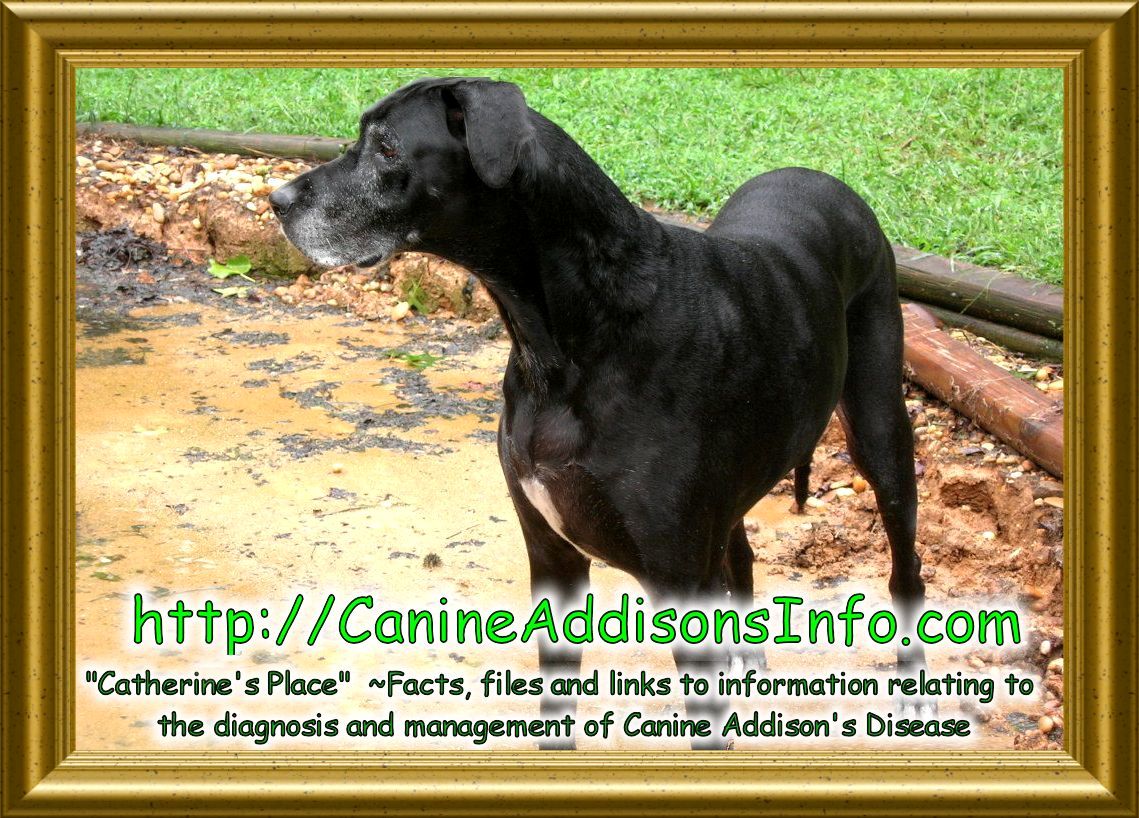Canine
Addison's Disease - Hypoadrenocorticism
Canine
Addison's Disease is *not*
a death sentence, as long as your dog
receives appropriate treatment. Dogs with Addison's Disease are unable
to produce one or two adrenal hormones, and treatment consists of
replacing those hormones with artificial substitutes: ie, hormone
replacement therapy!
A
properly medicated ADog shouldn’t look, act, or feel any different than
a dog whose adrenal glands were providing those hormones. Inside and
out, all signs of the disease, and the medications used to treat it,
should be invisible!
The
first hormone that's missing (the ONLY one missing in dogs with primary
"Atypical" or secondary Addison's) is cortisol, which manages
metabolism, stress, blood pressure and the general sense of well being.
Cortisol is a GLUCocorticoid (think glucose, sugar, energy) and is
artificially supplemented with a low DAILY dose of prednisone or some
other oral glucocorticoid (prednisolone, hydrocortisone, etc.) The
correct dose of prednisone cannot be measured with a blood test - it's
determined by your observations: the lowest dose that keeps your dog
symptom free, happy and eating!
The
second hormone that's missing (in dogs with primary "Typical" Addison's
only) is aldosterone, which manages amd balances the electrolytes in
the body. Aldosterone is a MINERALocorticoid (think minerals: salt,
sodium, potassium) and is artificially supplemented with monthly
injections of DOCP (Percorten-V
and Zycortal are identical, except for preservatives and
carrier), or
daily oral dosing with Florinef, in amounts sufficient to achieve and
maintain normal, balanced levels of these minerals.
Although there
are recommended *starting* doses for Florinef (one 0.1 mg tablet
for every TEN pounds of body weight) and DOCP (1.0 ml for 25
pounds of
body weight), recent studies indicate excellent results can be
achieved using
a “low dose protocol” with DOCP.
Whether
you begin high, low or in between, the *correct* dose must be
individualized, determined by closely monitoring electrolyte levels and
adjusting the dose according to the individual dog’s
response. Your
goal is to maintain potassium and sodium values at a "happy medium" of
whatever reference range the testing lab states on your dog's lab
report. Values
at
either extreme end of these ranges are usually not a "comfort zone" for
your Addisonian dog, and can actually be life-threatening!
For
personalized guidance and immediate feedback, please check into the
“Canine Addison’s Resources & Education (CARE)” support group on
Facebook. For your convenience, below is a direct link:
https://www.facebook.com/groups/CanineAddisonsResourcesAndEducation/
Dogs
with Addison's Disease can and DO lead full and happy lives once
they're provided with artificial replacements for the hormones their
adrenal glands are no longer producing!
About
us: Catherine's story... Introducing "Catherine" (Lady Catherine von
Licorice, CGC), diagnosed with Primary/Typical Addison's Disease
12/11/99) The story of Catherine's diagnosis was second in a three part
series of articles on Canine Addison's Disease, published by Ginnie
Saunders on "DaDane of the Week". http://www.Ginnie.com/DaDane369.shtml
Copyright 2006 - 2024
CanineAddisonsInfo.com - All rights
reserved. © Permission to use information, pictures
and/or graphics located on these pages MUST be obtained in writing by
contacting
info@canineaddisonsinfo.com

